- Home
- Gary Vaynerchuk
The Thank You Economy Page 2
The Thank You Economy Read online
Page 2
* * *
That’s what I mean about revealing your company’s heart and soul. There’s only so low you can go on price. There’s only so excellent you can make your product or service. There’s only so far you can stretch your marketing budget. Your heart, though—that’s boundless. Maybe it doesn’t sound realistic to expect anyone to be that emotional in business, but hey, how many people thought they would be tending to a virtual farm three years ago? Meanwhile, at its peak Farmville saw 85 million players.
Now, I realize that your reality isn’t boundless; scaling one-to-one relationships and hiring employees to help you costs money and time. But in this book, I’ll show you that when you spend money on social media, you’re not actually investing in a platform—you’re investing in a culture, and in consumers who can ultimately become your ambassadors. We’ll examine the return on investment and talk about how to make every dollar count. Ideally, though, your goal should be “No Interaction Left Behind,” because what pays off most is your willingness to show people that you care—about them, about their experience with you, about their business.
It’s not as hokey as it sounds. In fact, it is exactly how the business world used to run. I believe that we are living through the early days of a dramatic cultural shift that is bringing us back full circle, and that the world we live and work in now operates in a way that is surprisingly similar to the one our great-grandparents knew. Social media has transformed our world into one great big small town, dominated, as all vibrant towns used to be, by the strength of relationships, the currency of caring, and the power of word of mouth. In order to succeed now and in the future, it’s going to be imperative that we remember what worked in the past.
When Caring Meant Business
If you’re lucky enough to spend any time around any eighty-or ninety-year-olds who still have their wits about them and their memory intact, you’ll inevitably hear them remark how much the world has changed since they were young. Most elderly people can easily identify many ways in which the world has changed for the better, but they often express more than a hint of regret for a time when things moved more slowly, when people knew their neighbors, and when strangers and friends alike were expected to treat each other with courtesy and respect (even if they didn’t feel like it). They’ll also reminisce about how retailers and local businesses made it a point to know your name and make you feel like family when you walked in. As well they should have. Whether you lived in a small town or one of the small-town communities re-created in city neighborhoods, it was entirely possible the business owners/managers had known you your whole life.
Back then, there was no need to encourage people to buy local. Local was, for the most part, all there was. If your mother bought her meat at Butcher Bob’s, it was pretty likely that you shopped at Butcher Bob’s, too. Butcher Bob knew your family, knew your tastes, and knew that during the cold months he should reserve a hambone for you to flavor your weekly batch of split-pea soup. How Butcher Bob treated you when you walked into his store was as crucial as the quality of his ground beef. It wasn’t that you only had to walk three blocks over to see what rival Butcher Bill had to offer in his case. It was that if you weren’t happy with the service you received—if, for example, Butcher Bob refused to reimburse you for the freshly ground chuck that you brought home only to discover it wasn’t so fresh—you’d vent your outrage to the PTA, or a trade union meeting, or the country club. That was Butcher Bob’s worst nightmare, if the PTA, trade unions, or country club members represented a big chunk of his customer base. To lose one disgruntled customer could often mean losing ten of his or her friends and relatives. In the smaller, tight-knit communities of yesteryear, ten people represented a lot of revenue. Businesses lived and died by what was said via word of mouth, and by the influence people had with one another. That meant every person who walked through the door had to feel as though he or she mattered. Unless he was the only game in town, the butcher, the baker, the candlestick maker—heck, everyone who had to deal with customers—had to be as friendly, accommodating, and, when necessary, apologetic as the other guy, if not more so.
This was an era when businesses could stay in family hands for several generations. Often, the business wasn’t just a way to make money; it was something the owners and managers closely identified with and in which they took pride. When the business was relatively new, the people who ran it often cared as though their life depended upon it because, well, it did. The business was their ticket to the American dream. This is what was going to launch their children’s future. They were in it for the long haul; it would be their legacy. And in the end, when they retired, they were probably still going to live among all the people with whom they had done business for many years. Their customers weren’t just walking wallets; they were friends and neighbors, so business owners cared about their customers. A lot.
Word of Mouth Loses Its Voice
That world our grandparents and great-grandparents knew, the one where relationships and word of mouth could have a direct impact on an individual’s personal and professional reputation, and on the success or failure of one’s business, began to disintegrate around the time when ordinary people like Butcher Bob bought their first car, in the years between the mid-to-late 1920s and the post–World War II boom. Around the middle of the last century, a whole lot of social and economic forces converged, and people took advantage of their affordable cars and the new highways built for them to head out to suburbia. As time went on, Americans started fleeing even farther, to exurbia. The countryside was paved with parking lots and lined with strip malls to serve the burgeoning commuter society. For many, the sign that you’d arrived was that you had managed to put as much distance as possible between yourself and everybody else, preferably with a gate.
These decades that brought greater distance between friends, family, and neighbors coincided with the rapid rise of big business. Butcher Bob retired just in time to avoid being crushed by the newly built Safeway supermarket chain, which would eventually include over two thousand stores across the country. If the company that treated Great-Grandma like royalty even when she was only buying a two-dollar hat had grown and prospered, in all probability a corporation gobbled it up. Eventually its reason for being became less about delighting the ladies with the newest fashions, or building a legacy, and more about satisfying quarterly returns and improving stock options. The prioritization of profit over principle quickly took over American corporate culture and is what shaped the perspective of all ranks of many of today’s business leaders. Most have never known anything else. They’re just playing the game as they were taught.
If You Don’t Care, No One Will
What happened next is almost forgivable. Almost. After all, consumers seemed to have rejected old-world values and abandoned small-town or community-oriented businesses. Plus, in the wake of a variety of social and cultural upheavals, manners took a nosedive. It was definitely time to ditch some of the fussy formalities society had long been saddled with, but manners—real manners—indicate that we care about other people’s feelings, and about their experience when they’re around us. It was almost as if big business looked around, took note of the increasingly relaxed social norms, and thought, “Well, shoot, if they don’t care, neither do we.” If people were going to expect very little, little is what they were going to get.
Companies started unloading anything that didn’t immediately and directly track to pumping up their bottom line. It wasn’t just about replacing the hats with cheaper, more modern fashions. Nor did it mean simply phasing out little extras that made a customer feel like royalty. It meant power bombing anything that showed the company cared about the customer experience at all. Supermarkets stopped hiring teenagers to load bags and carry them to the car. Gas station attendants disappeared except in New Jersey and Oregon. And if you wanted to speak to a company about their product or service, you could press 1 to spell your name, press 2 to place an order, press 3 for more o
ptions, or press the star key to return to the main menu. As the 1980s rolled into the 1990s and companies relied increasingly on automated call centers, we were ushered into a customer service dark ages.
People griped and moaned, but there was nothing they could do. Some even swallowed the company lie that eliminating the unnecessary, time-consuming, expensive perks that customers used to take for granted—such as the privilege of speaking to a live human being—made it possible to keep prices down. We loved talking to you, but our loss is your gain. Enjoy the savings!
The Internet only made everything worse. For all its globalizing properties, it allowed us to take our isolationism even further. Now we didn’t even have to go to the mall to do our shopping or the megaplex to see a movie. No matter where we lived, in fact, with the click of a mouse we could bring the world—or rather, the world as we wanted to see it, with a selection of entertainment, politics, and media cherry-picked to meet our individual tastes—straight to us without ever having to speak to another live human being. We could order our groceries online. We never had to leave the house. We could conceivably become a community of one.
For business, our Internet love affair was a gift from the gods. Online startups exploded and the target markets for existing companies dramatically expanded. Businesses could now point proudly to their websites and assure their customers that the lines of communication would never close. In theory, the website made them available 24/7. In reality, with a few exceptions, these corporate websites merely made it that much easier to truly pander to the idea of service without actually providing any. In fact, it made it possible for them to virtually avoid dealing with customers altogether. Now people could waste even more time clicking around on websites in a fruitless effort to find a phone number or the name of someone to speak with. When all that was available was an email address, they could send out a question, complaint, or comment into the ether and wait God knows how long until receiving a totally bland, formulaic, and useless reply. In the event they could dig up a phone number, they wasted millions, maybe even billions of hours per year on hold, or being transferred from one helpless or hapless rep to another. As companies outsourced their customer service, customers struggled to make themselves understood by script-reading foreigners. They seethed, but as usual, there was nothing they could do.
Corporations had nothing to fear. Their customer base was no longer in the local zip codes within a five-or even fifteen-mile radius—it was the entire country, and in some cases, the whole world. So what if one person got her panties in a bunch? Or a hundred? How many people, realistically, were going to take the time to find sites like Paypalsucks.com, read them, post on them, and tell their friends? How many friends could they possibly tell, anyway? It just wasn’t worth the time, money, or effort to handle each customer, whether satisfied or disgruntled, with anything other than a token bit of goodwill. The ROI didn’t justify doing things any other way.
Small-Town Living Moves Online
Then, around 2003, in the midst of this high-tech, digital, impersonal world, a new train started bulleting across the online landscape. It was nothing like the trains our great-grandparents might have ridden, but for all its shiny digital modernity, in essence it closed the vast distances created over a near-century of car culture, cheap land, and technology. Many of us still lived far apart from one another, but we were about to be connected in a totally small-town way.
The train was Web 2.0, now known as social media. It rode along the rails of the Web at breathtaking speed, every one of its cars a powerful platform designed with the express purpose of getting people to talk to one another again. The silent, anonymous, private Internet suddenly turned extremely chatty, personal, and revealing. Small-town living moved online as people eagerly sought out each other’s latest news. Our morning social media browse to check in on what everyone has been up to became the equivalent of the old-timers’ early morning stroll to the diner for pancakes and coffee. We check Facebook and comment on a friend’s photo of her new shoes (which we know without asking are Kate Spades and were bought at Nordstrom’s because she said so in her status update) the same way we once would have remarked, “You look lovely in that hat, Margie,” as we passed by our neighbor. We click “like” upon seeing our friend’s status update announcing his kid’s college graduation the same way we’d have nodded approvingly upon seeing that little Timmy had finally gotten the hang of his Radio Flyer scooter. We tweet an article and accompany it with some curses for the city management clowns bungling up yet another public works project with the same energy we’d use to rattle our newspaper and vent our frustration to all the other folks lined up next to us at the diner counter reading their paper, sipping their coffee—plain, black—and chewing on a doughnut.
Social media allowed us to become more aware of the minutiae in each other’s lives, of what was going on, of what people were thinking and doing, than ever before. In the 1940s, we’d have found out about the progress of our neighbor’s new wall-papering project or model ship during run-ins at the bus stop or the Piggly Wiggly. In 1990 we might not have known about these projects at all. And in 2010, we can not only know about them, we can see pictures and video chronicling their progress and get information about the retailers and service providers involved. In the beginning, a lot of people saw the banality of the topics flying around and wondered who could possibly care that Jeff in Boulder had found a half-eaten bag of Snickers in the pantry, or that Liz in Miami was heading out to the beach for a run in her new Pumas. But people did care. Society jumped on the chance to re-create the regular exchanges of personal news and thoughts that used to be a staple of those smaller, relationship-based communities.
A Full-Circle Power Shift
Still, most businesses, save for some ambitious entrepreneurs, didn’t see any upside to jumping on that train. Where could it possibly go that could be of use to them? Many leaders failed to see—some of them still fail to see—that the game they all learned to play has finally started to change. (Those changes are going to be insane in five years!) By allowing dialogues to occur and relationships to grow on a daily basis, for free, between people living as far apart as Des Moines and Osaka who might never actually meet in person, social media represents a gigantic power shift back to the consumer. Consumers have more direct, daily contact with other consumers than has ever been possible in the history of the planet. More contact means more sharing of information, gossiping, exchanging, engaging—in short, more word of mouth. Now, Jeff’s friend on the other side of the country, whom he hasn’t seen in six years and who has fast-forwarded through every television commercial since getting his first DVR in 2003, might see Jeff’s post about the half-eaten Snickers, remember how much he likes that candy bar, and pick one up that afternoon while waiting in the supermarket checkout line. That’s a plausible scenario that Great-Grandma could never have foreseen.
How the New Word of Mouth Is Different
Word of mouth is back. When society cut the close personal and business ties that existed in older, smaller communities, people became like ants scattered around on a picnic table—really busy, really strong, but too far apart from one another to get much accomplished as a unit. Now, the Internet has matured so that the power of social media can allow all the ants to collectively gather under the table, and they’re strong enough to haul it away if they so choose. Any businessperson who can’t see the repercussions of that much potential word of mouth has his or her eyes closed. For example, even if Martha isn’t that interested in agriculture or the subject of genetically modified food, the fact that her friend in Hamburg is might be enough to make her pay attention when spotting a post on a social networking or microblogging site (Twitter, Posterous, Tumblr) about the activities of some company called Monsanto. Maybe she reads the attached link and starts to form an opinion, and then reposts or retweets so that her two hundred friends can see why she feels the way she does. She then enjoys the heated conversation that ensues with the twenty-
five people who reply. Of those twenty-five people, eighteen repost and retweet the original article, with a personal message attached, to their respective friends. According to Facebook, as of 2010, the average Facebook user has 130 friends, and the average Twitter account holder has 300 followers, which in total add up to a potential 7,740 people who suddenly have Monsanto’s name flying in front of their eyes. That doesn’t even factor in the 175 people who had access to Martha’s original post but didn’t say anything to Martha about it. Some saw it, some didn’t. But of those who did, who knows how many silently reposted it to people who might then, in turn, have reposted it? Think about how many thousands of people that represents. And, many of them did it immediately from the smartphone that goes everywhere they go. There’s no more lag between the time someone hears, reads, or sees something and the time that person can get back to a computer and shoot out an email to a dozen friends. News and information that had always traveled fast, whether being transmitted in older, tiny communities via front porch or window ledge or in larger ones by balcony, fire escape, phone, or email, is now traveling across the world in real time. A crucial difference between the spread of information and opinion then and now, though, is that the recipients of that information and opinion more often care about the individual sending it to them. Middlemen, pundits, and spokespersons no longer have a near-monopoly on the widespread distribution of a brand or a company’s message.
We talk more passionately about things we care about than about things toward which we are ambivalent. We listen more closely to people we care about than to people we do not know. And now, we are talking and listening in unprecedented numbers, and our opinions and purchasing decisions are being affected and influenced even as we stand in the store aisle and weigh our options.

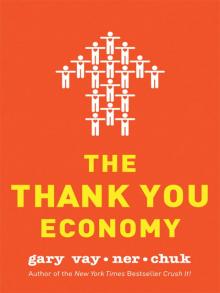 The Thank You Economy
The Thank You Economy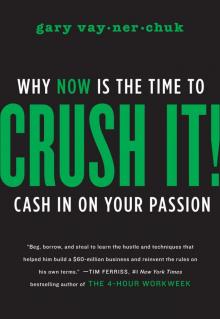 Crush It!
Crush It!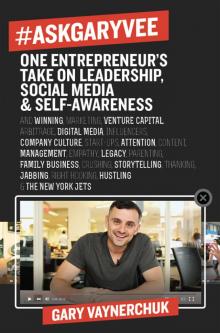 #AskGaryVee
#AskGaryVee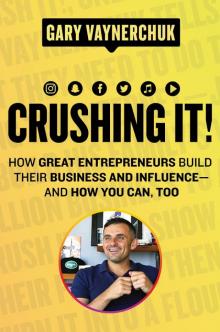 Crushing It! EPB
Crushing It! EPB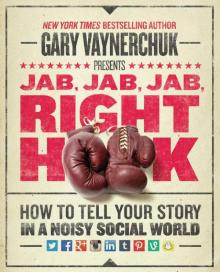 Jab, Jab, Jab, Right Hook
Jab, Jab, Jab, Right Hook